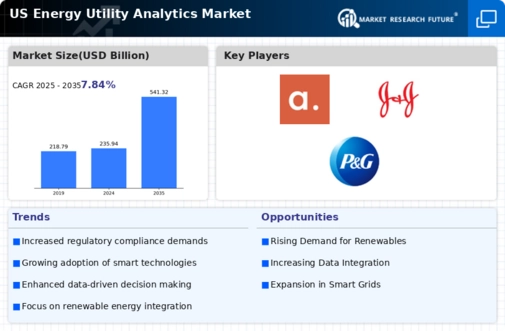The competitive landscape of the US Energy Utility Analytics Market is characterized by a rapidly evolving environment where companies are leveraging advanced analytics to enhance operational efficiency and customer engagement. The market has gained significant traction due to increasing demands for smart grid technologies, data-driven decision-making, and regulatory pressures for improved service delivery. Organizations within this space utilize big data, machine learning, and predictive analytics to optimize energy distribution, reduce costs, and enhance reliability.
The competitive dynamics are influenced by the unique capabilities of players in the sector, as well as their strategic partnerships, innovations, and ability to adapt to changing market conditions, which collectively shape their market standing.FirstEnergy has established itself as a prominent player in the US Energy Utility Analytics Market, leveraging its extensive experience and resources to drive innovation.
The company's ability to harness data analytics has resulted in improved grid performance and enhanced customer service. FirstEnergy’s robust infrastructure enables it to efficiently monitor and manage energy distribution, while its strong commitment to sustainability and regulatory compliance enhances its reputation within the market. Furthermore, the company has a notable presence across multiple states, allowing it to tap into diverse regional markets effectively.
Its focus on technological advancements and continuous improvement positions FirstEnergy favorably against competitors and allows it to respond to industry challenges swiftly.PSEG operates as a significant entity in the US Energy Utility Analytics Market, showcasing its prowess through a combination of innovative offerings and strategic initiatives. The company provides a range of analytics solutions tailored for energy efficiency, grid management, and customer insights. PSEG’s extensive market presence is bolstered by its commitment to utilizing advanced technologies that optimize utility operations, significantly lowering costs, and improving service reliability.
The organization has pursued strategic mergers and acquisitions to enhance its capabilities and expand its footprint in the analytics space, thereby fostering a culture of continuous improvement and adaptation. PSEG’s strengths lie in its data-driven approach, which ensures that it meets the evolving needs of customers while adhering to regulatory demands. In summary, PSEG exemplifies how a utility can effectively integrate analytics into its operations to drive growth and operational excellence within the US energy landscape.














Leave a Comment